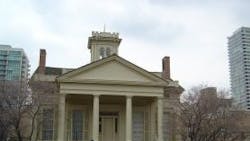Without modern utilities, how were Chicago's early mansions kept warm, cool, and lighted? Chicago's Clark house, the oldest surviving house built in 1836, had floor to ceiling windows. Open a window in the ceiling of the 3rd floor and air was pulled from the “widow's walk” on the roof through the house. Walah…air conditioning. 4 fireplaces heated the home, and mirrors set strategically through out the house reflected candle light to brighten the areas at night.
A huge 18,000 sq.ft. mansion built in 1886, the Glessner house had a fireplace in every room. The north side of the 3+ storied house had very narrow windows and a long servants' hall that acted like a buffer to keep the interior rooms warm. The half basement school room had not only a fireplace, but a 5' x 6' wall hung metal radiant heater, to keep the children warm. The large dining room boasted a curved south wall with 5 large windows to receive the sun's heat. Gas chandeliers and lamps provided light.
Which house did I prefer? The Glessner house. It had 10 servants!
About the Author
Gene Wolf Blog
Technical Writer
Gene Wolf has been designing and building substations and other high technology facilities for over 32 years. He received his BSEE from Wichita State University. He received his MSEE from New Mexico State University. He is a registered professional engineer in the states of California and New Mexico. He started his career as a substation engineer for Kansas Gas and Electric, retired as the Principal Engineer of Stations for Public Service Company of New Mexico recently, and founded Lone Wolf Engineering, LLC an engineering consulting company.
Gene is widely recognized as a technical leader in the electric power industry. Gene is a fellow of the IEEE. He is the former Chairman of the IEEE PES T&D Committee. He has held the position of the Chairman of the HVDC & FACTS Subcommittee and membership in many T&D working groups. Gene is also active in renewable energy. He sponsored the formation of the “Integration of Renewable Energy into the Transmission & Distribution Grids” subcommittee and the “Intelligent Grid Transmission and Distribution” subcommittee within the Transmission and Distribution committee.
